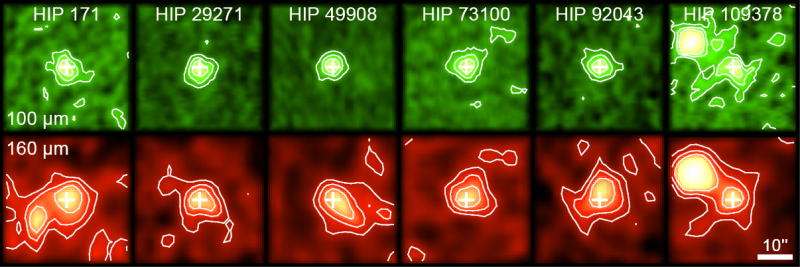Details of HERSCHEL'S "COLD DEBRIS DISKS"
Herschel images of some debris disks
Grafik: A.V. Krivov, AIUThe "cold debris disks", as these belts were dubbed, are larger, and possilbly more massive, than the Kuiper belt in the Solar system. Our Kuiper belt, however, comprises a number of objects hundreds or thousands of kilometer in size, called dwarf planets, including the famous "ex-planet" Pluto. The Herschel's cold disks do not. They are probably made of myriads of small icy chunks and boulders that have grown on the periphery of these systems. For some reasons that we have not yet understood, the planetary growth must have stopped early, before the "usual" sizes have been reached.
Although planets, and even dwarf planets, failed to grow on the outskirts of these systems - they may well exist much closer to the central stars. Indeed, a planet has been discovered earlier around one of those stars, appearing under a number 109378 in the Hipparcos catalog, but its orbit is a hundred times smaller than the size of the disks. It is a strange feeling to think that these stars may be orbited by planets, one of which may even be habitable, and that astronomers possibly living there would probably not be aware of these belts. It is simply because there are no large "Plutos" or "Sednas" there to discover, and the faint infrared emission of the entire belt would be distributed across their sky - so it would be hard to detect from inside such a system. It is easier seen from afar...
"Easier" does not mean "easy", however. Herschel, the largest telescope ever operating in space, had an unprecedented observing power - but the emission of "cold disks" is so dim that their observations were pushing to the limits even the unrivaled sensisitity and resolution of this space observatory. We cannot exclude, for instance, that one or two of these six rogues are in fact not related to their stars - they may be faint distant galaxies on the background, coincidentally lying behind the stars. We are pretty sure, however, that most of them are true disks - and thus the challenging phenomenon is real and needs to be explained.
It will be extremely difficult to get more insights into the nature of these strange systems, based in the Herschel data alone. Other instruments, such as ALMA, CCAT or Spica will help - and eventually give answers to all the questions that remain unanswered. This will help better understand the diversity of planetary systems - and how the nature creates them.
Read the full story in Krivov et al. 2013Externer Link
